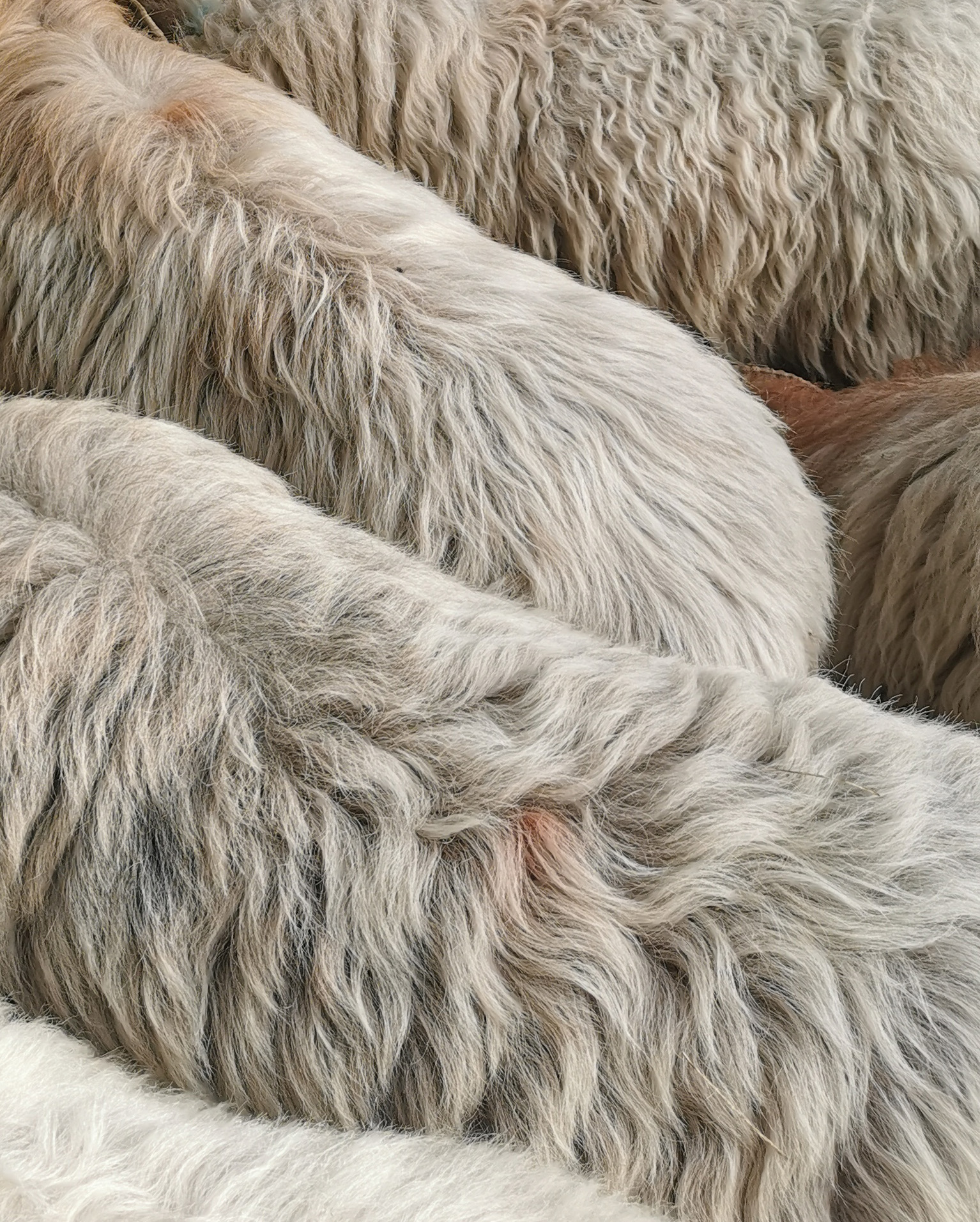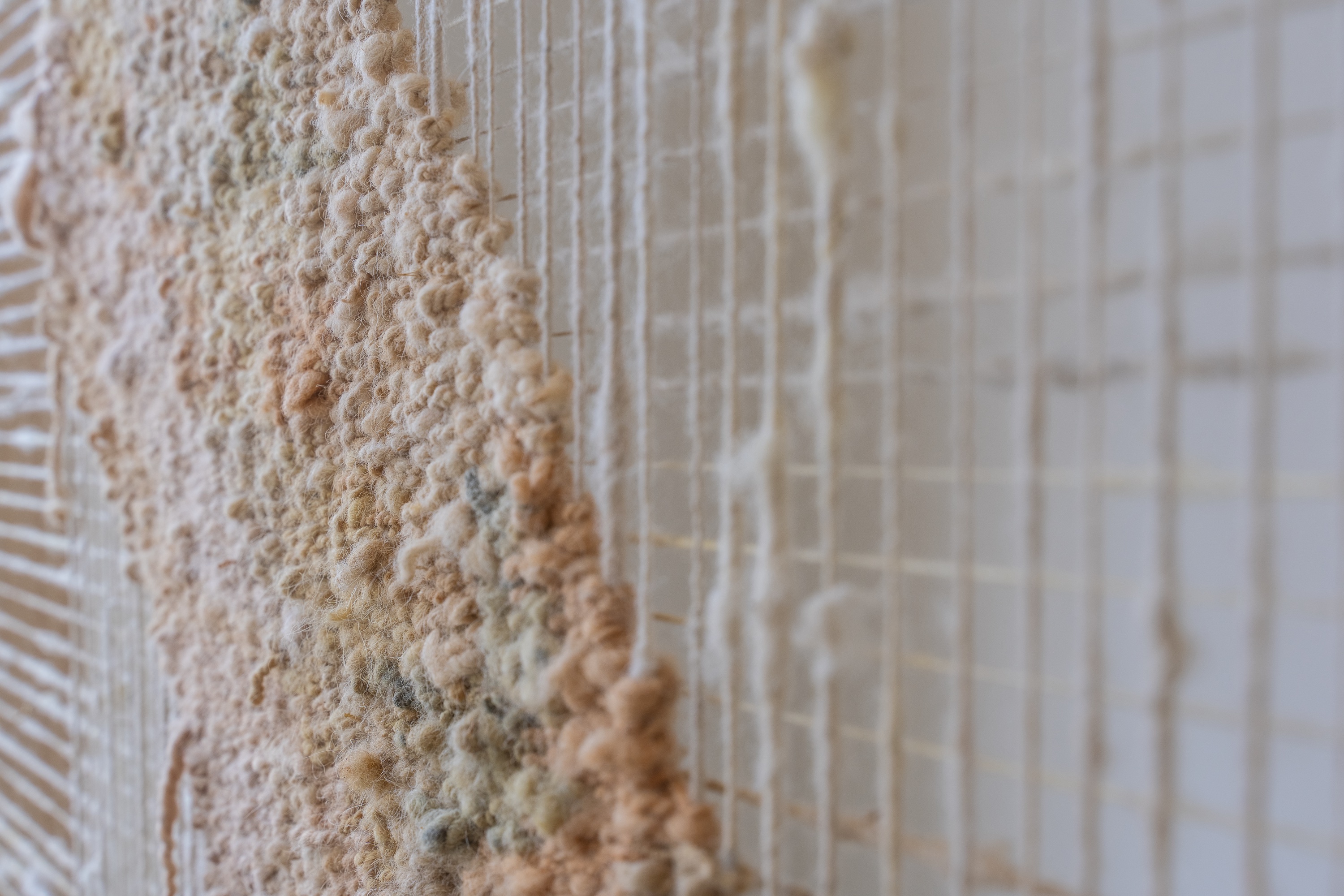Twining Threads
–
Chiara Veenstra
–
Chiara Veenstra
Twining Threads is an installation consisting of a woollen tapestry along with everything needed to produce it, from the spinning wheel to the plants that the pigments used are derived from. It is the visual outcome of research into Solleveld and Kapittelduinen, a dune landscape near the Hague, and depicts the intertwining relations between sheep, sea buckthorn, and nitrogen. After mapping some of the relations present within this landscape, I found that the main reason sheep populate the dunes is due to the flourishing of sea buckthorn. This particular plant outgrows other grasses and plants due to the high amount of nitrogen in the soil, which comes from nitrogen deposition in the area.
![]()
Ranging from green to ochre yellow, orange, and red in colour, the wool in the tapestry is dyed using different parts of the sea buckthorn, like the bark, leaves, and berries. Wool is the carrier of the particular relations between the sheep, sea buckthorn and nitrogen I found within the landscape. While researching, I wondered how it is possible that wool, from the moment it is shorn and treated as a ‘raw material’, has hardly any monetary value in the Netherlands, so I looked further into local wool production. I visited farms, talked to farmers about the economic incentives within the agricultural sector, and went on walks with shepherds.
![]()
![]()
Tracing the material to the landscapes it originates from, as Jane Hutton describes in Reciprocal Landscapes, Stories of Material Movements, helped me to explore existing ecological and economic relationships, and made me question how these relationships could become more reciprocal, incorporating human and non-human actors within surrounding ecologies.[1] I chose the dunes as my case study due to the reciprocity I observed here.
[1] Jane Hutton, Reciprocal Landscapes, Stories of Material Movements (New York: Routledge, 2021).
![]()
![]()
My aim with this project was ultimately to explore the origin of a material, and to understand how value is related to a material’s trajectory and landscape. A material is a carrier of stories, of landscapes, and therefore of relationships between all actors present there. The creation of value of a material doesn’t start the moment that I, as a designer, get to work with it, but long before that process. How do I, as a designer, negotiate landscapes not extractively but with reciprocity?
![]()
Studying at MID helped me rethink the role designers have in working relationally and critically, learning from the positions of non-human and human actors, industries, and their histories. Looking closely and specifically at these relations as a designer creates the opportunity to pinpoint and illustrate friction or overlooked points of view. What I take away for my further practice is finding ways in which reciprocal relationships, within landscapes where materials originate, can and should be of influence on ideas of value in industrialised systems and design processes.
![]()

Ranging from green to ochre yellow, orange, and red in colour, the wool in the tapestry is dyed using different parts of the sea buckthorn, like the bark, leaves, and berries. Wool is the carrier of the particular relations between the sheep, sea buckthorn and nitrogen I found within the landscape. While researching, I wondered how it is possible that wool, from the moment it is shorn and treated as a ‘raw material’, has hardly any monetary value in the Netherlands, so I looked further into local wool production. I visited farms, talked to farmers about the economic incentives within the agricultural sector, and went on walks with shepherds.


Tracing the material to the landscapes it originates from, as Jane Hutton describes in Reciprocal Landscapes, Stories of Material Movements, helped me to explore existing ecological and economic relationships, and made me question how these relationships could become more reciprocal, incorporating human and non-human actors within surrounding ecologies.[1] I chose the dunes as my case study due to the reciprocity I observed here.
[1] Jane Hutton, Reciprocal Landscapes, Stories of Material Movements (New York: Routledge, 2021).


My aim with this project was ultimately to explore the origin of a material, and to understand how value is related to a material’s trajectory and landscape. A material is a carrier of stories, of landscapes, and therefore of relationships between all actors present there. The creation of value of a material doesn’t start the moment that I, as a designer, get to work with it, but long before that process. How do I, as a designer, negotiate landscapes not extractively but with reciprocity?

Studying at MID helped me rethink the role designers have in working relationally and critically, learning from the positions of non-human and human actors, industries, and their histories. Looking closely and specifically at these relations as a designer creates the opportunity to pinpoint and illustrate friction or overlooked points of view. What I take away for my further practice is finding ways in which reciprocal relationships, within landscapes where materials originate, can and should be of influence on ideas of value in industrialised systems and design processes.
